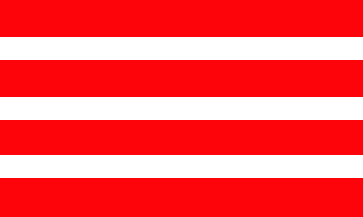
by Jaume Olle, 17 May 2002

Last modified: 2023-01-28 by martin karner
Keywords: kerch | crimea | krym | krim | griffin | key | anchor |
Links: FOTW homepage |
search |
disclaimer and copyright |
write us |
mirrors
See also:
From the site of Ukrainian
Heraldry:
"The flag of city constitutes by itself a rectangular from
seven horizontal bars - 4 red and 3 white. Symbolics of colours
the writer interpreted so: white - cleanness of thoughts, honour
and denomination; red - bravery, boldness, fidelity Rhodinum,
memory about a blood. The quantity of red bars symbolizes
historical periods of development of city: antiquity, middle
ages, revival, modernity, and also 4 main peoples, which formed
the historical past of city.
The main architect of city has reduced also such interesting
argument: in Kerch there is a most ancient acting orthodox temple
in Ukraine - church of Ioann. On its facade a unique red-white
orament."
Dov Gutterman, 20 November 2000
From the image in the site of Ukrainian
Heraldry, the red stripes are 0.16 x the hoist and the white
ones 0.12 x the hoist.
Ivan Sache, 23 November 2000
The flag of Kerch, as shown in the site of the Ukranian
Heraldry society, is R with three horizontal W stripes. The size
of stripes is smaller that background. Considering a flag of 36:
54 the stripes of white are 4:54 each and the red background
6:54. This is: 6:4:6:4:6:4:6.
Source: Znak 21.
Jaume Olle, 17 May 2002
kr_ke.gif)
from the site of Ukrainian
Heraldry
kr-ke.gif)
Large Coat of Arms
from the site of Ukrainian
Heraldry
From the site of Ukrainian
Heraldry:
"On the 11th of November 1994 the executive committee of the
town council confirmed (resolution ? 1448) a new modern Coat of
Arms: an or griffin is in a gules field. In shield compartment -
or key with an oval ring. In the upper and lower parts of the
oval there are cuts. The key has a key-bit with a cross-shaped
cut in the center. The pictures of the griffin and the key are
traced out with sable, the shield is traced with an or edged.
The large Coat of Arms was affirmed by October, 19, 1999 on the
extraordinary session of municipal council.
The description of the "smart" coat of arms was
presented (without a figure) in the application No. 2 to solution
of municipal council from June, 20, 1996. The Coat of Arms is
framed by wreath from or oak and laurel branches within by
fillets of red and light-blue colours. The board is imposed on
two crossed black admiral's anchor. The coat of arms is crowned
by Russian imperial crown. Below on an intersection of branches
and fillets the placed Golden Star of the city-hero. From words
of the writer two anchors are two seas (Azov and Black), between
which there is a city, it is two ports - trade and fishing. Red
Alexander's fillet belonged city till in XIX century, and
light-blue Andrew's to 100 years to annexation of Crimea to
Russian empire (the writer of these strings - V.Nerubenko from
Kerch - such data does not possess, but still in 1993 offered
instead of it a red-yellow fillet of an Lenin award). Russian
imperial crown means that Kerch in due course was affiliated by
first among the Crimean cities to Russia. "
Dov Gutterman, 20 November 2000
From the site of Ukrainian
Heraldry:
"In the VI century B.C. it was the capital of Bospor State
and had the name of Pantikapei. Since VI century it was a
Byzantine fortress. In the X century on the banks of Kerchensky
strait there was a T'mutarakans'ke principality which was part of
Kyiv Rus'. Since the XIII century it was a Genoese port Cherkio,
since 1475 - a Turkish fortress. After 1771 Kerch was part of
Russian Empire."
Dov Gutterman, 20 November 2000
Kerch was founded in the 6th century by Milesians as
Panticapaeum (Pantikapaion?); with surrounding territory formed
kingdom of the Cimmerian Bosporus, which was later conquered by
Mithridates of Pontus. It was held by Huns, Khazars and other
invaders of Crimea. Trading port held by Genoese from 14th to
15th century, when Turks captured it. Its conquest by Russia was
confirmed in 1774. Shredded to pieces in Crimean War. In World
War II occupied by Germans May 1942-April 1944, and all Jews in
the town were murdered. In 1944 again shredded to pieces.
Sources: Webster's New Geographical Dictionary, 1985;
and Neil Ascherson: Black Sea, 1995.
Jarig Bakker, 21 November 2000